Corporate Accounting: Fair Value Reporting of ASX Companies
VerifiedAdded on 2023/06/04
|10
|2523
|149
Report
AI Summary
This report provides a comprehensive analysis of fair value accounting in corporate settings. It begins by exploring the relevance of fair value accounting in the contemporary world, discussing its advantages over historical cost and its impact on financial statement users, including investors and creditors. The report then delves into the use of fair value in both private and public sectors and examines its role in the subprime crisis, highlighting the controversies and criticisms associated with its application. The second part of the report focuses on a comparative analysis of two ASX-listed companies, the Commercial Bank of Australia (CBA) and Australia and New Zealand Bank (ANZ), detailing their similarities and differences in applying fair value accounting to various assets and liabilities. The analysis includes a discussion of how each bank measures and reports its financial instruments, providing valuable insights into their financial reporting practices.
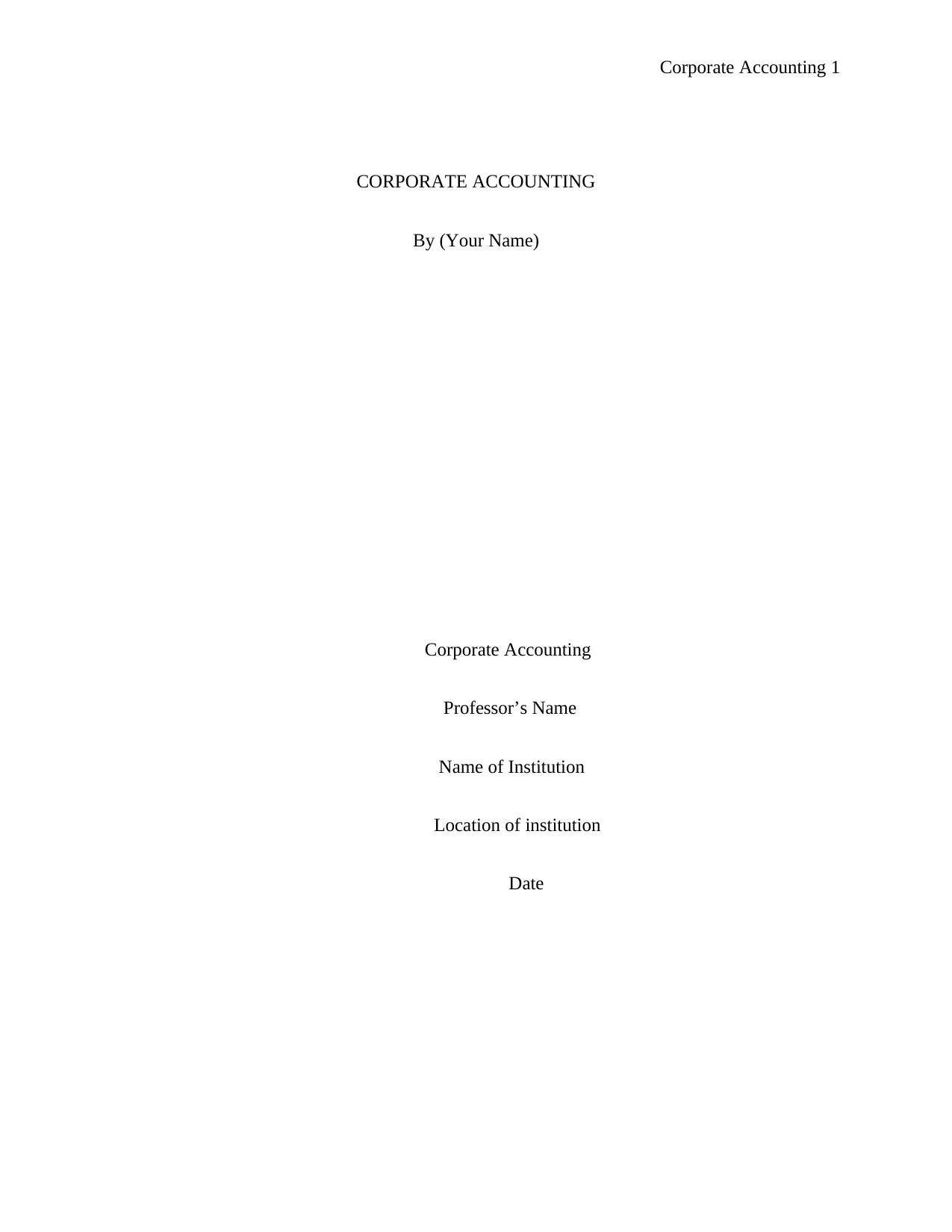
Corporate Accounting 1
CORPORATE ACCOUNTING
By (Your Name)
Corporate Accounting
Professor’s Name
Name of Institution
Location of institution
Date
CORPORATE ACCOUNTING
By (Your Name)
Corporate Accounting
Professor’s Name
Name of Institution
Location of institution
Date
Paraphrase This Document
Need a fresh take? Get an instant paraphrase of this document with our AI Paraphraser
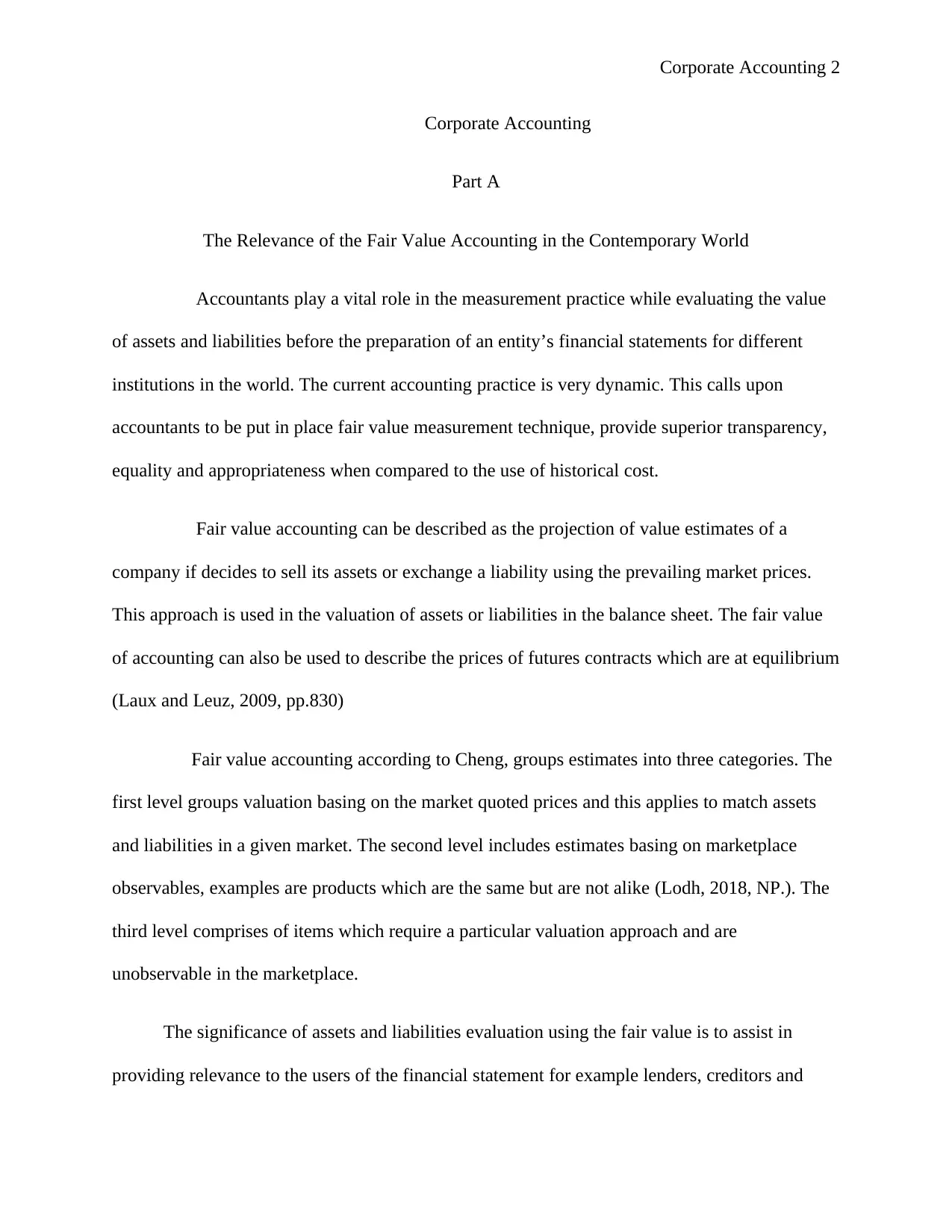
Corporate Accounting 2
Corporate Accounting
Part A
The Relevance of the Fair Value Accounting in the Contemporary World
Accountants play a vital role in the measurement practice while evaluating the value
of assets and liabilities before the preparation of an entity’s financial statements for different
institutions in the world. The current accounting practice is very dynamic. This calls upon
accountants to be put in place fair value measurement technique, provide superior transparency,
equality and appropriateness when compared to the use of historical cost.
Fair value accounting can be described as the projection of value estimates of a
company if decides to sell its assets or exchange a liability using the prevailing market prices.
This approach is used in the valuation of assets or liabilities in the balance sheet. The fair value
of accounting can also be used to describe the prices of futures contracts which are at equilibrium
(Laux and Leuz, 2009, pp.830)
Fair value accounting according to Cheng, groups estimates into three categories. The
first level groups valuation basing on the market quoted prices and this applies to match assets
and liabilities in a given market. The second level includes estimates basing on marketplace
observables, examples are products which are the same but are not alike (Lodh, 2018, NP.). The
third level comprises of items which require a particular valuation approach and are
unobservable in the marketplace.
The significance of assets and liabilities evaluation using the fair value is to assist in
providing relevance to the users of the financial statement for example lenders, creditors and
Corporate Accounting
Part A
The Relevance of the Fair Value Accounting in the Contemporary World
Accountants play a vital role in the measurement practice while evaluating the value
of assets and liabilities before the preparation of an entity’s financial statements for different
institutions in the world. The current accounting practice is very dynamic. This calls upon
accountants to be put in place fair value measurement technique, provide superior transparency,
equality and appropriateness when compared to the use of historical cost.
Fair value accounting can be described as the projection of value estimates of a
company if decides to sell its assets or exchange a liability using the prevailing market prices.
This approach is used in the valuation of assets or liabilities in the balance sheet. The fair value
of accounting can also be used to describe the prices of futures contracts which are at equilibrium
(Laux and Leuz, 2009, pp.830)
Fair value accounting according to Cheng, groups estimates into three categories. The
first level groups valuation basing on the market quoted prices and this applies to match assets
and liabilities in a given market. The second level includes estimates basing on marketplace
observables, examples are products which are the same but are not alike (Lodh, 2018, NP.). The
third level comprises of items which require a particular valuation approach and are
unobservable in the marketplace.
The significance of assets and liabilities evaluation using the fair value is to assist in
providing relevance to the users of the financial statement for example lenders, creditors and
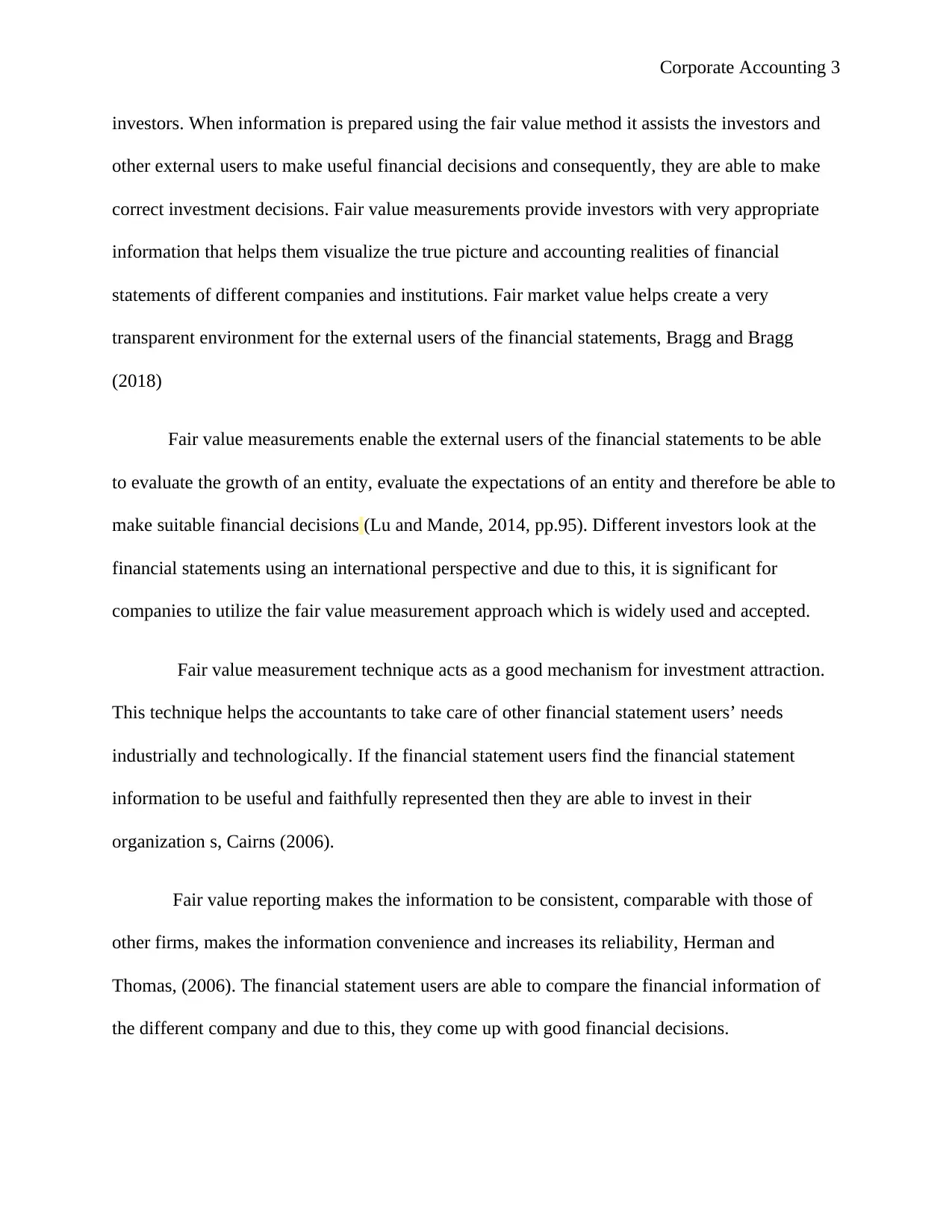
Corporate Accounting 3
investors. When information is prepared using the fair value method it assists the investors and
other external users to make useful financial decisions and consequently, they are able to make
correct investment decisions. Fair value measurements provide investors with very appropriate
information that helps them visualize the true picture and accounting realities of financial
statements of different companies and institutions. Fair market value helps create a very
transparent environment for the external users of the financial statements, Bragg and Bragg
(2018)
Fair value measurements enable the external users of the financial statements to be able
to evaluate the growth of an entity, evaluate the expectations of an entity and therefore be able to
make suitable financial decisions (Lu and Mande, 2014, pp.95). Different investors look at the
financial statements using an international perspective and due to this, it is significant for
companies to utilize the fair value measurement approach which is widely used and accepted.
Fair value measurement technique acts as a good mechanism for investment attraction.
This technique helps the accountants to take care of other financial statement users’ needs
industrially and technologically. If the financial statement users find the financial statement
information to be useful and faithfully represented then they are able to invest in their
organization s, Cairns (2006).
Fair value reporting makes the information to be consistent, comparable with those of
other firms, makes the information convenience and increases its reliability, Herman and
Thomas, (2006). The financial statement users are able to compare the financial information of
the different company and due to this, they come up with good financial decisions.
investors. When information is prepared using the fair value method it assists the investors and
other external users to make useful financial decisions and consequently, they are able to make
correct investment decisions. Fair value measurements provide investors with very appropriate
information that helps them visualize the true picture and accounting realities of financial
statements of different companies and institutions. Fair market value helps create a very
transparent environment for the external users of the financial statements, Bragg and Bragg
(2018)
Fair value measurements enable the external users of the financial statements to be able
to evaluate the growth of an entity, evaluate the expectations of an entity and therefore be able to
make suitable financial decisions (Lu and Mande, 2014, pp.95). Different investors look at the
financial statements using an international perspective and due to this, it is significant for
companies to utilize the fair value measurement approach which is widely used and accepted.
Fair value measurement technique acts as a good mechanism for investment attraction.
This technique helps the accountants to take care of other financial statement users’ needs
industrially and technologically. If the financial statement users find the financial statement
information to be useful and faithfully represented then they are able to invest in their
organization s, Cairns (2006).
Fair value reporting makes the information to be consistent, comparable with those of
other firms, makes the information convenience and increases its reliability, Herman and
Thomas, (2006). The financial statement users are able to compare the financial information of
the different company and due to this, they come up with good financial decisions.
⊘ This is a preview!⊘
Do you want full access?
Subscribe today to unlock all pages.

Trusted by 1+ million students worldwide
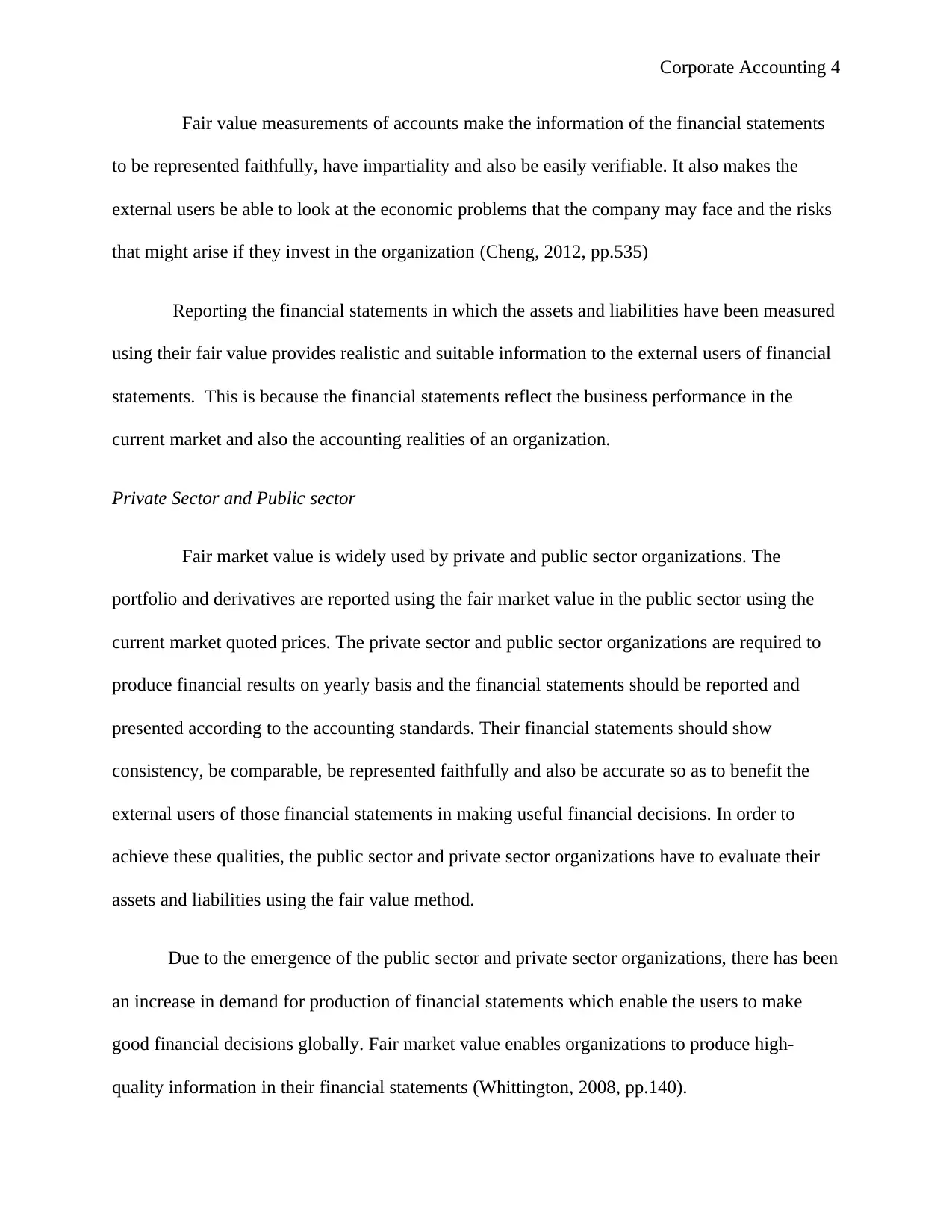
Corporate Accounting 4
Fair value measurements of accounts make the information of the financial statements
to be represented faithfully, have impartiality and also be easily verifiable. It also makes the
external users be able to look at the economic problems that the company may face and the risks
that might arise if they invest in the organization (Cheng, 2012, pp.535)
Reporting the financial statements in which the assets and liabilities have been measured
using their fair value provides realistic and suitable information to the external users of financial
statements. This is because the financial statements reflect the business performance in the
current market and also the accounting realities of an organization.
Private Sector and Public sector
Fair market value is widely used by private and public sector organizations. The
portfolio and derivatives are reported using the fair market value in the public sector using the
current market quoted prices. The private sector and public sector organizations are required to
produce financial results on yearly basis and the financial statements should be reported and
presented according to the accounting standards. Their financial statements should show
consistency, be comparable, be represented faithfully and also be accurate so as to benefit the
external users of those financial statements in making useful financial decisions. In order to
achieve these qualities, the public sector and private sector organizations have to evaluate their
assets and liabilities using the fair value method.
Due to the emergence of the public sector and private sector organizations, there has been
an increase in demand for production of financial statements which enable the users to make
good financial decisions globally. Fair market value enables organizations to produce high-
quality information in their financial statements (Whittington, 2008, pp.140).
Fair value measurements of accounts make the information of the financial statements
to be represented faithfully, have impartiality and also be easily verifiable. It also makes the
external users be able to look at the economic problems that the company may face and the risks
that might arise if they invest in the organization (Cheng, 2012, pp.535)
Reporting the financial statements in which the assets and liabilities have been measured
using their fair value provides realistic and suitable information to the external users of financial
statements. This is because the financial statements reflect the business performance in the
current market and also the accounting realities of an organization.
Private Sector and Public sector
Fair market value is widely used by private and public sector organizations. The
portfolio and derivatives are reported using the fair market value in the public sector using the
current market quoted prices. The private sector and public sector organizations are required to
produce financial results on yearly basis and the financial statements should be reported and
presented according to the accounting standards. Their financial statements should show
consistency, be comparable, be represented faithfully and also be accurate so as to benefit the
external users of those financial statements in making useful financial decisions. In order to
achieve these qualities, the public sector and private sector organizations have to evaluate their
assets and liabilities using the fair value method.
Due to the emergence of the public sector and private sector organizations, there has been
an increase in demand for production of financial statements which enable the users to make
good financial decisions globally. Fair market value enables organizations to produce high-
quality information in their financial statements (Whittington, 2008, pp.140).
Paraphrase This Document
Need a fresh take? Get an instant paraphrase of this document with our AI Paraphraser
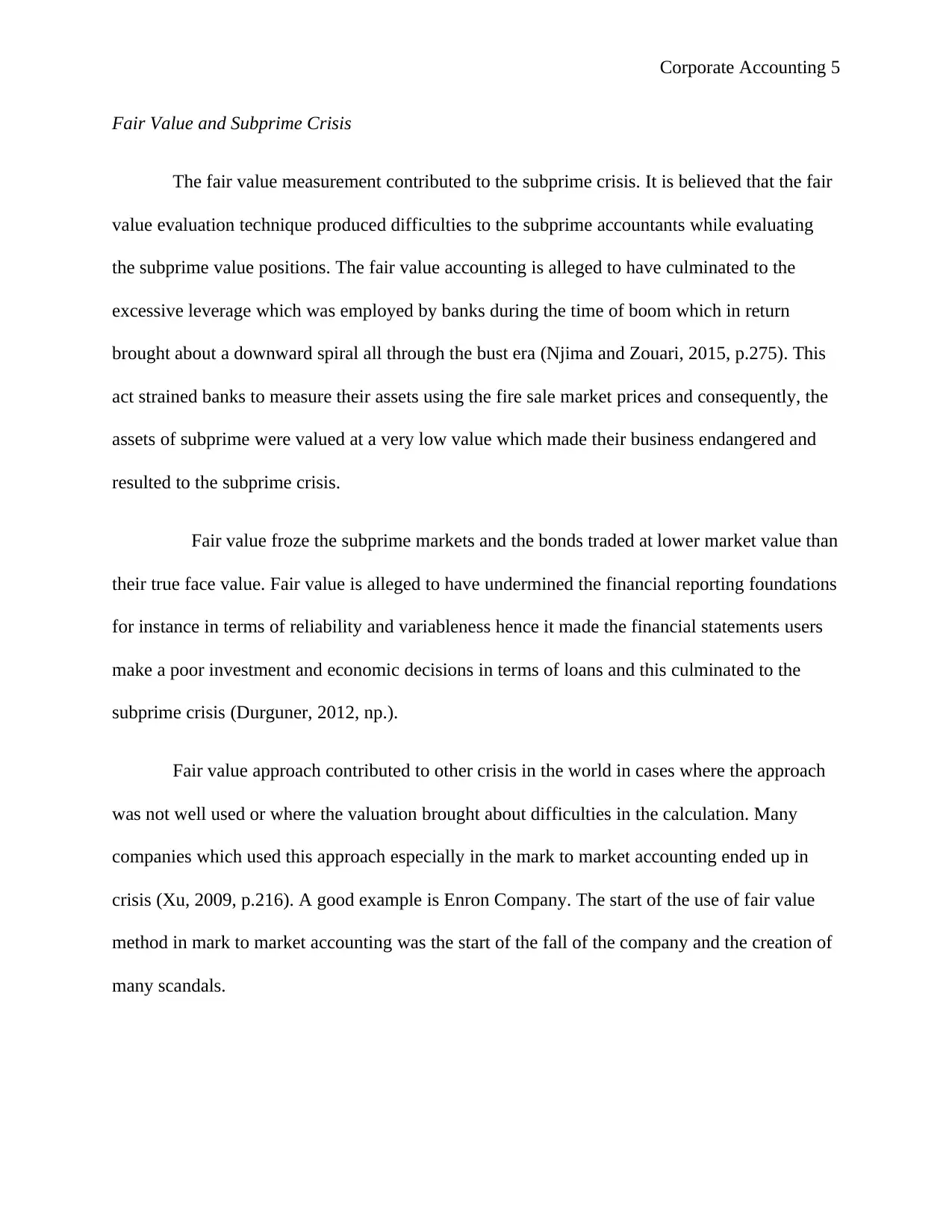
Corporate Accounting 5
Fair Value and Subprime Crisis
The fair value measurement contributed to the subprime crisis. It is believed that the fair
value evaluation technique produced difficulties to the subprime accountants while evaluating
the subprime value positions. The fair value accounting is alleged to have culminated to the
excessive leverage which was employed by banks during the time of boom which in return
brought about a downward spiral all through the bust era (Njima and Zouari, 2015, p.275). This
act strained banks to measure their assets using the fire sale market prices and consequently, the
assets of subprime were valued at a very low value which made their business endangered and
resulted to the subprime crisis.
Fair value froze the subprime markets and the bonds traded at lower market value than
their true face value. Fair value is alleged to have undermined the financial reporting foundations
for instance in terms of reliability and variableness hence it made the financial statements users
make a poor investment and economic decisions in terms of loans and this culminated to the
subprime crisis (Durguner, 2012, np.).
Fair value approach contributed to other crisis in the world in cases where the approach
was not well used or where the valuation brought about difficulties in the calculation. Many
companies which used this approach especially in the mark to market accounting ended up in
crisis (Xu, 2009, p.216). A good example is Enron Company. The start of the use of fair value
method in mark to market accounting was the start of the fall of the company and the creation of
many scandals.
Fair Value and Subprime Crisis
The fair value measurement contributed to the subprime crisis. It is believed that the fair
value evaluation technique produced difficulties to the subprime accountants while evaluating
the subprime value positions. The fair value accounting is alleged to have culminated to the
excessive leverage which was employed by banks during the time of boom which in return
brought about a downward spiral all through the bust era (Njima and Zouari, 2015, p.275). This
act strained banks to measure their assets using the fire sale market prices and consequently, the
assets of subprime were valued at a very low value which made their business endangered and
resulted to the subprime crisis.
Fair value froze the subprime markets and the bonds traded at lower market value than
their true face value. Fair value is alleged to have undermined the financial reporting foundations
for instance in terms of reliability and variableness hence it made the financial statements users
make a poor investment and economic decisions in terms of loans and this culminated to the
subprime crisis (Durguner, 2012, np.).
Fair value approach contributed to other crisis in the world in cases where the approach
was not well used or where the valuation brought about difficulties in the calculation. Many
companies which used this approach especially in the mark to market accounting ended up in
crisis (Xu, 2009, p.216). A good example is Enron Company. The start of the use of fair value
method in mark to market accounting was the start of the fall of the company and the creation of
many scandals.
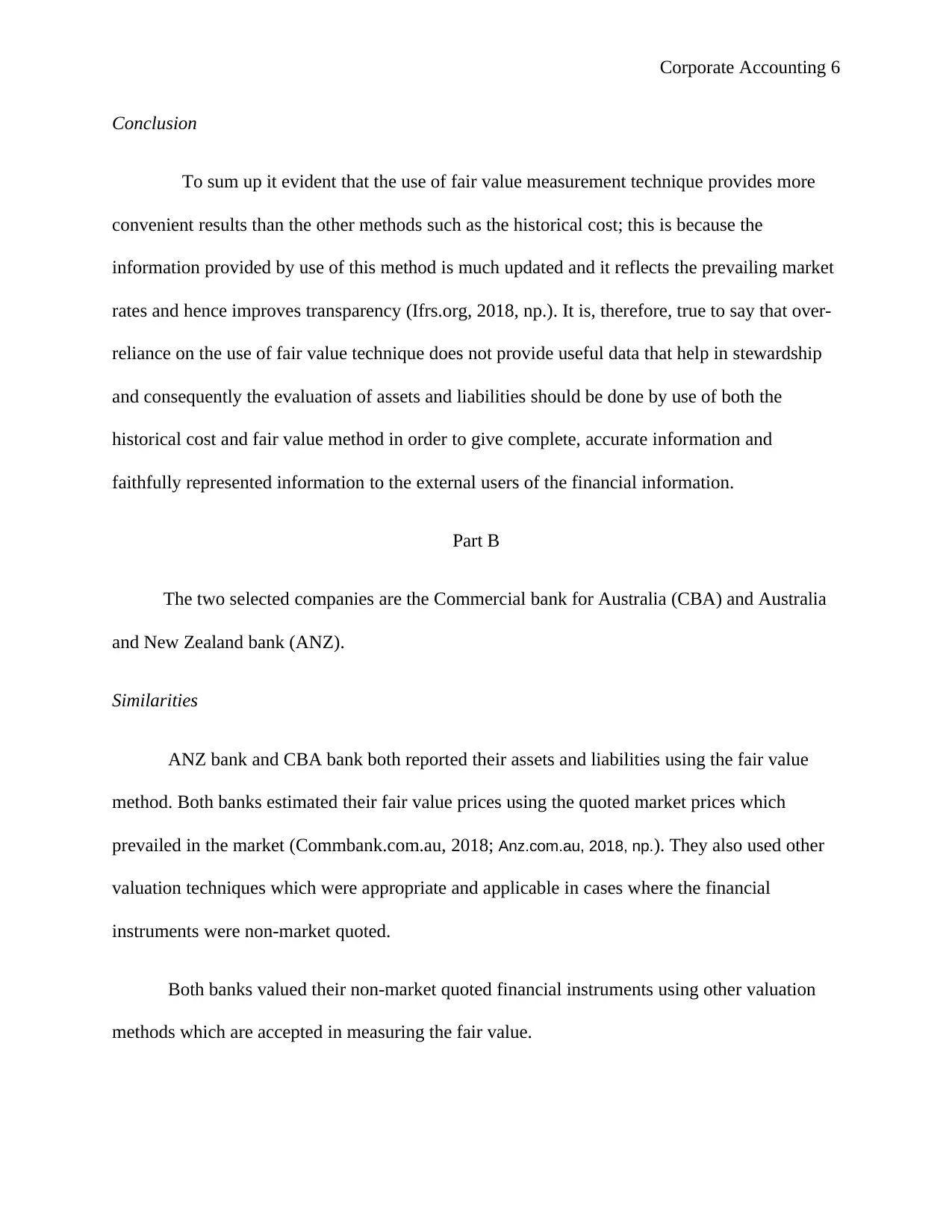
Corporate Accounting 6
Conclusion
To sum up it evident that the use of fair value measurement technique provides more
convenient results than the other methods such as the historical cost; this is because the
information provided by use of this method is much updated and it reflects the prevailing market
rates and hence improves transparency (Ifrs.org, 2018, np.). It is, therefore, true to say that over-
reliance on the use of fair value technique does not provide useful data that help in stewardship
and consequently the evaluation of assets and liabilities should be done by use of both the
historical cost and fair value method in order to give complete, accurate information and
faithfully represented information to the external users of the financial information.
Part B
The two selected companies are the Commercial bank for Australia (CBA) and Australia
and New Zealand bank (ANZ).
Similarities
ANZ bank and CBA bank both reported their assets and liabilities using the fair value
method. Both banks estimated their fair value prices using the quoted market prices which
prevailed in the market (Commbank.com.au, 2018; Anz.com.au, 2018, np.). They also used other
valuation techniques which were appropriate and applicable in cases where the financial
instruments were non-market quoted.
Both banks valued their non-market quoted financial instruments using other valuation
methods which are accepted in measuring the fair value.
Conclusion
To sum up it evident that the use of fair value measurement technique provides more
convenient results than the other methods such as the historical cost; this is because the
information provided by use of this method is much updated and it reflects the prevailing market
rates and hence improves transparency (Ifrs.org, 2018, np.). It is, therefore, true to say that over-
reliance on the use of fair value technique does not provide useful data that help in stewardship
and consequently the evaluation of assets and liabilities should be done by use of both the
historical cost and fair value method in order to give complete, accurate information and
faithfully represented information to the external users of the financial information.
Part B
The two selected companies are the Commercial bank for Australia (CBA) and Australia
and New Zealand bank (ANZ).
Similarities
ANZ bank and CBA bank both reported their assets and liabilities using the fair value
method. Both banks estimated their fair value prices using the quoted market prices which
prevailed in the market (Commbank.com.au, 2018; Anz.com.au, 2018, np.). They also used other
valuation techniques which were appropriate and applicable in cases where the financial
instruments were non-market quoted.
Both banks valued their non-market quoted financial instruments using other valuation
methods which are accepted in measuring the fair value.
⊘ This is a preview!⊘
Do you want full access?
Subscribe today to unlock all pages.

Trusted by 1+ million students worldwide
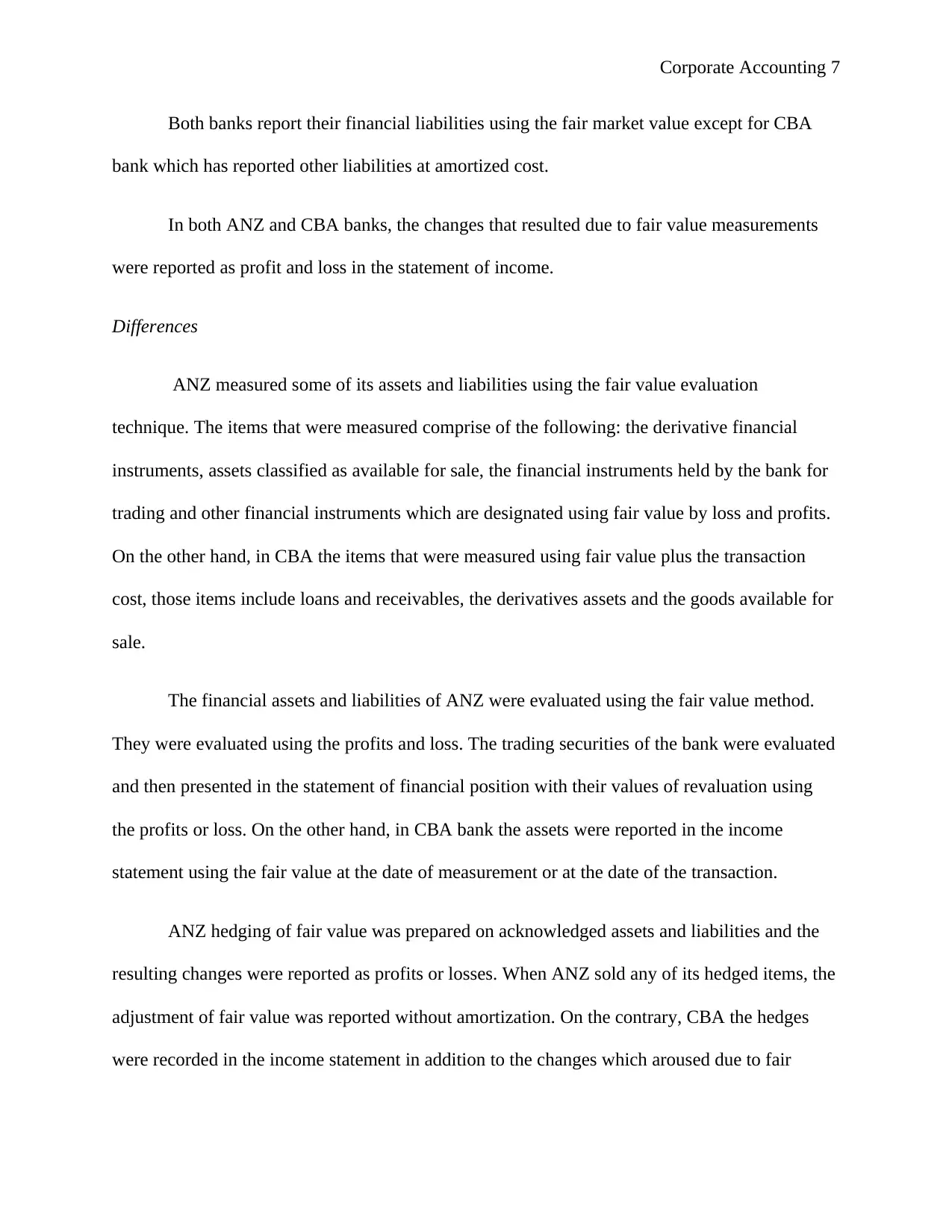
Corporate Accounting 7
Both banks report their financial liabilities using the fair market value except for CBA
bank which has reported other liabilities at amortized cost.
In both ANZ and CBA banks, the changes that resulted due to fair value measurements
were reported as profit and loss in the statement of income.
Differences
ANZ measured some of its assets and liabilities using the fair value evaluation
technique. The items that were measured comprise of the following: the derivative financial
instruments, assets classified as available for sale, the financial instruments held by the bank for
trading and other financial instruments which are designated using fair value by loss and profits.
On the other hand, in CBA the items that were measured using fair value plus the transaction
cost, those items include loans and receivables, the derivatives assets and the goods available for
sale.
The financial assets and liabilities of ANZ were evaluated using the fair value method.
They were evaluated using the profits and loss. The trading securities of the bank were evaluated
and then presented in the statement of financial position with their values of revaluation using
the profits or loss. On the other hand, in CBA bank the assets were reported in the income
statement using the fair value at the date of measurement or at the date of the transaction.
ANZ hedging of fair value was prepared on acknowledged assets and liabilities and the
resulting changes were reported as profits or losses. When ANZ sold any of its hedged items, the
adjustment of fair value was reported without amortization. On the contrary, CBA the hedges
were recorded in the income statement in addition to the changes which aroused due to fair
Both banks report their financial liabilities using the fair market value except for CBA
bank which has reported other liabilities at amortized cost.
In both ANZ and CBA banks, the changes that resulted due to fair value measurements
were reported as profit and loss in the statement of income.
Differences
ANZ measured some of its assets and liabilities using the fair value evaluation
technique. The items that were measured comprise of the following: the derivative financial
instruments, assets classified as available for sale, the financial instruments held by the bank for
trading and other financial instruments which are designated using fair value by loss and profits.
On the other hand, in CBA the items that were measured using fair value plus the transaction
cost, those items include loans and receivables, the derivatives assets and the goods available for
sale.
The financial assets and liabilities of ANZ were evaluated using the fair value method.
They were evaluated using the profits and loss. The trading securities of the bank were evaluated
and then presented in the statement of financial position with their values of revaluation using
the profits or loss. On the other hand, in CBA bank the assets were reported in the income
statement using the fair value at the date of measurement or at the date of the transaction.
ANZ hedging of fair value was prepared on acknowledged assets and liabilities and the
resulting changes were reported as profits or losses. When ANZ sold any of its hedged items, the
adjustment of fair value was reported without amortization. On the contrary, CBA the hedges
were recorded in the income statement in addition to the changes which aroused due to fair
Paraphrase This Document
Need a fresh take? Get an instant paraphrase of this document with our AI Paraphraser
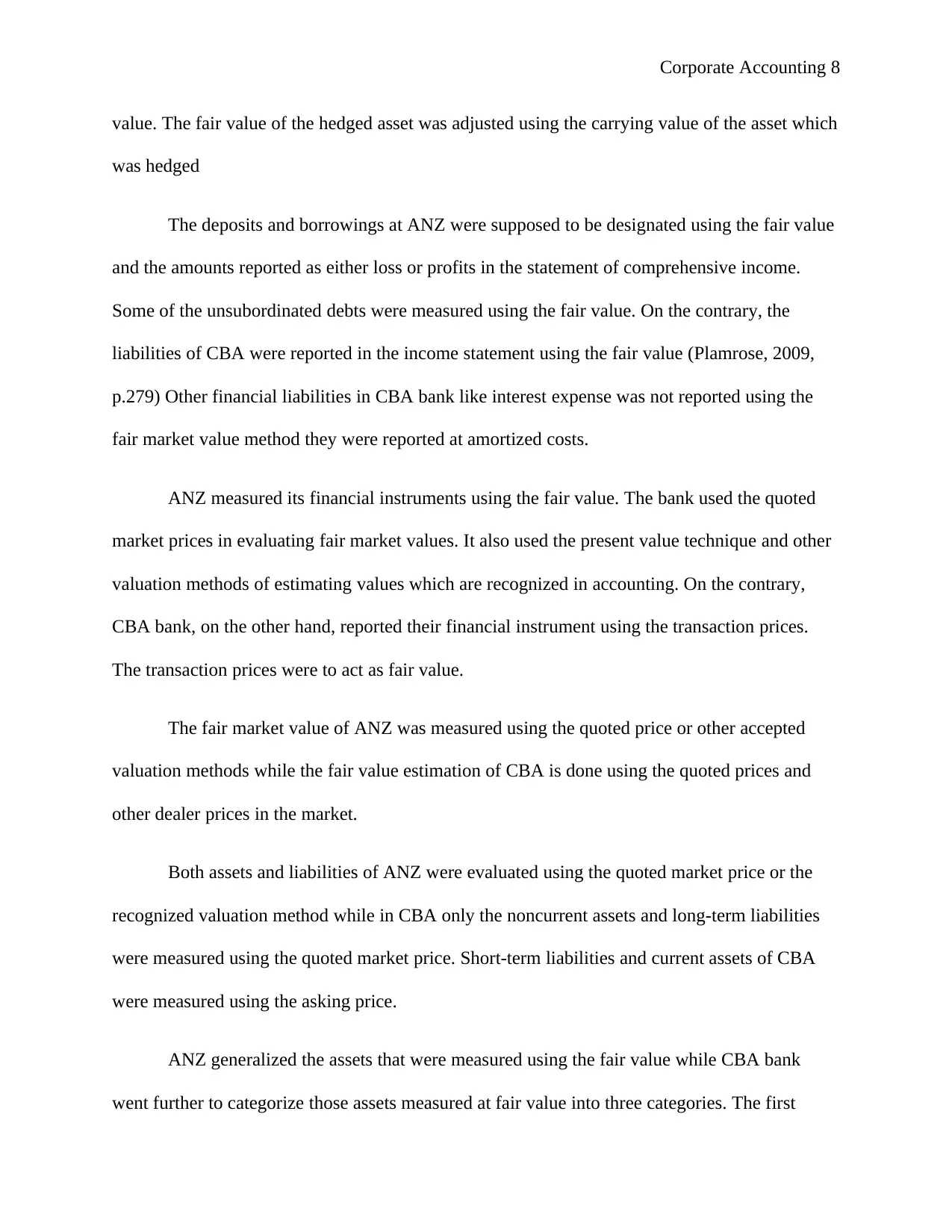
Corporate Accounting 8
value. The fair value of the hedged asset was adjusted using the carrying value of the asset which
was hedged
The deposits and borrowings at ANZ were supposed to be designated using the fair value
and the amounts reported as either loss or profits in the statement of comprehensive income.
Some of the unsubordinated debts were measured using the fair value. On the contrary, the
liabilities of CBA were reported in the income statement using the fair value (Plamrose, 2009,
p.279) Other financial liabilities in CBA bank like interest expense was not reported using the
fair market value method they were reported at amortized costs.
ANZ measured its financial instruments using the fair value. The bank used the quoted
market prices in evaluating fair market values. It also used the present value technique and other
valuation methods of estimating values which are recognized in accounting. On the contrary,
CBA bank, on the other hand, reported their financial instrument using the transaction prices.
The transaction prices were to act as fair value.
The fair market value of ANZ was measured using the quoted price or other accepted
valuation methods while the fair value estimation of CBA is done using the quoted prices and
other dealer prices in the market.
Both assets and liabilities of ANZ were evaluated using the quoted market price or the
recognized valuation method while in CBA only the noncurrent assets and long-term liabilities
were measured using the quoted market price. Short-term liabilities and current assets of CBA
were measured using the asking price.
ANZ generalized the assets that were measured using the fair value while CBA bank
went further to categorize those assets measured at fair value into three categories. The first
value. The fair value of the hedged asset was adjusted using the carrying value of the asset which
was hedged
The deposits and borrowings at ANZ were supposed to be designated using the fair value
and the amounts reported as either loss or profits in the statement of comprehensive income.
Some of the unsubordinated debts were measured using the fair value. On the contrary, the
liabilities of CBA were reported in the income statement using the fair value (Plamrose, 2009,
p.279) Other financial liabilities in CBA bank like interest expense was not reported using the
fair market value method they were reported at amortized costs.
ANZ measured its financial instruments using the fair value. The bank used the quoted
market prices in evaluating fair market values. It also used the present value technique and other
valuation methods of estimating values which are recognized in accounting. On the contrary,
CBA bank, on the other hand, reported their financial instrument using the transaction prices.
The transaction prices were to act as fair value.
The fair market value of ANZ was measured using the quoted price or other accepted
valuation methods while the fair value estimation of CBA is done using the quoted prices and
other dealer prices in the market.
Both assets and liabilities of ANZ were evaluated using the quoted market price or the
recognized valuation method while in CBA only the noncurrent assets and long-term liabilities
were measured using the quoted market price. Short-term liabilities and current assets of CBA
were measured using the asking price.
ANZ generalized the assets that were measured using the fair value while CBA bank
went further to categorize those assets measured at fair value into three categories. The first
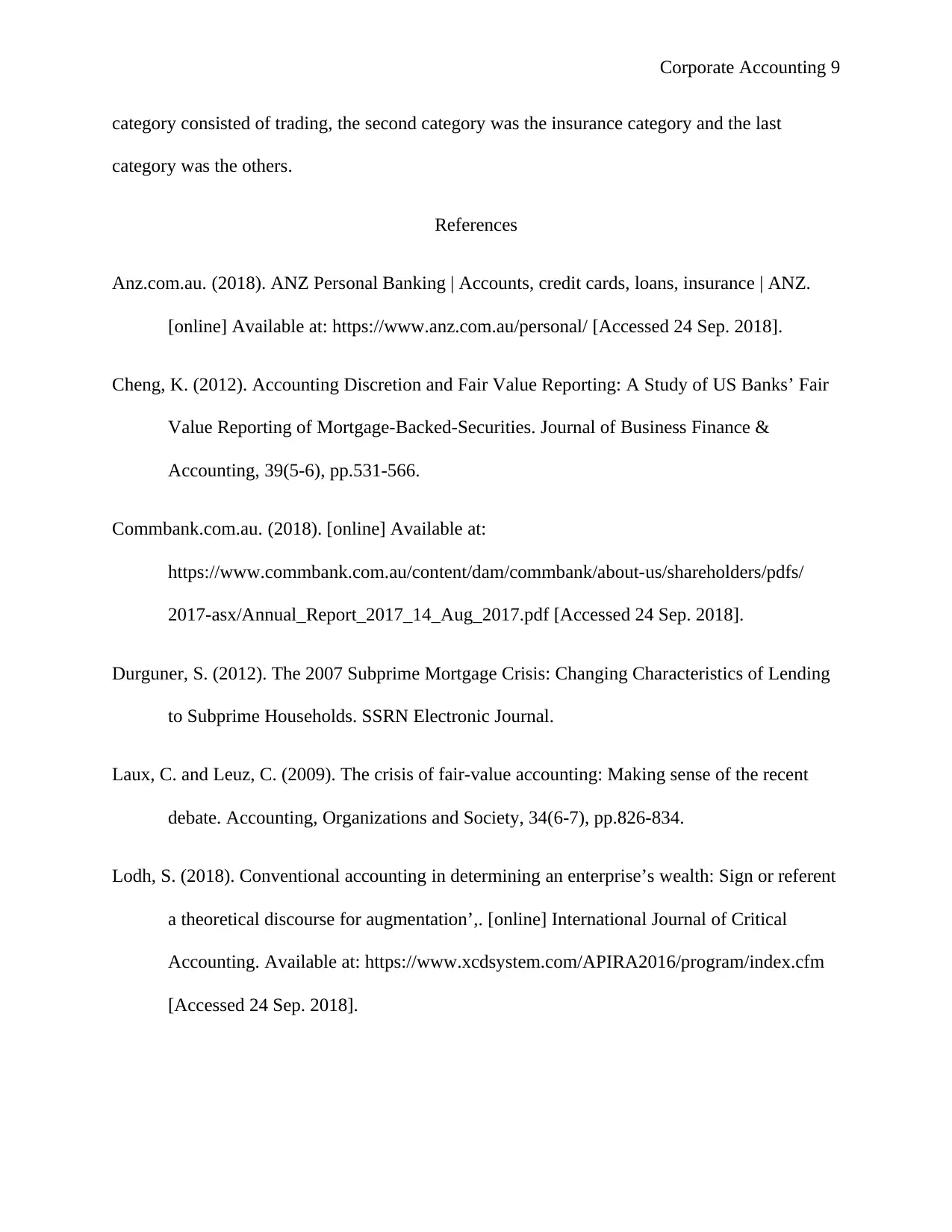
Corporate Accounting 9
category consisted of trading, the second category was the insurance category and the last
category was the others.
References
Anz.com.au. (2018). ANZ Personal Banking | Accounts, credit cards, loans, insurance | ANZ.
[online] Available at: https://www.anz.com.au/personal/ [Accessed 24 Sep. 2018].
Cheng, K. (2012). Accounting Discretion and Fair Value Reporting: A Study of US Banks’ Fair
Value Reporting of Mortgage-Backed-Securities. Journal of Business Finance &
Accounting, 39(5-6), pp.531-566.
Commbank.com.au. (2018). [online] Available at:
https://www.commbank.com.au/content/dam/commbank/about-us/shareholders/pdfs/
2017-asx/Annual_Report_2017_14_Aug_2017.pdf [Accessed 24 Sep. 2018].
Durguner, S. (2012). The 2007 Subprime Mortgage Crisis: Changing Characteristics of Lending
to Subprime Households. SSRN Electronic Journal.
Laux, C. and Leuz, C. (2009). The crisis of fair-value accounting: Making sense of the recent
debate. Accounting, Organizations and Society, 34(6-7), pp.826-834.
Lodh, S. (2018). Conventional accounting in determining an enterprise’s wealth: Sign or referent
a theoretical discourse for augmentation’,. [online] International Journal of Critical
Accounting. Available at: https://www.xcdsystem.com/APIRA2016/program/index.cfm
[Accessed 24 Sep. 2018].
category consisted of trading, the second category was the insurance category and the last
category was the others.
References
Anz.com.au. (2018). ANZ Personal Banking | Accounts, credit cards, loans, insurance | ANZ.
[online] Available at: https://www.anz.com.au/personal/ [Accessed 24 Sep. 2018].
Cheng, K. (2012). Accounting Discretion and Fair Value Reporting: A Study of US Banks’ Fair
Value Reporting of Mortgage-Backed-Securities. Journal of Business Finance &
Accounting, 39(5-6), pp.531-566.
Commbank.com.au. (2018). [online] Available at:
https://www.commbank.com.au/content/dam/commbank/about-us/shareholders/pdfs/
2017-asx/Annual_Report_2017_14_Aug_2017.pdf [Accessed 24 Sep. 2018].
Durguner, S. (2012). The 2007 Subprime Mortgage Crisis: Changing Characteristics of Lending
to Subprime Households. SSRN Electronic Journal.
Laux, C. and Leuz, C. (2009). The crisis of fair-value accounting: Making sense of the recent
debate. Accounting, Organizations and Society, 34(6-7), pp.826-834.
Lodh, S. (2018). Conventional accounting in determining an enterprise’s wealth: Sign or referent
a theoretical discourse for augmentation’,. [online] International Journal of Critical
Accounting. Available at: https://www.xcdsystem.com/APIRA2016/program/index.cfm
[Accessed 24 Sep. 2018].
⊘ This is a preview!⊘
Do you want full access?
Subscribe today to unlock all pages.

Trusted by 1+ million students worldwide
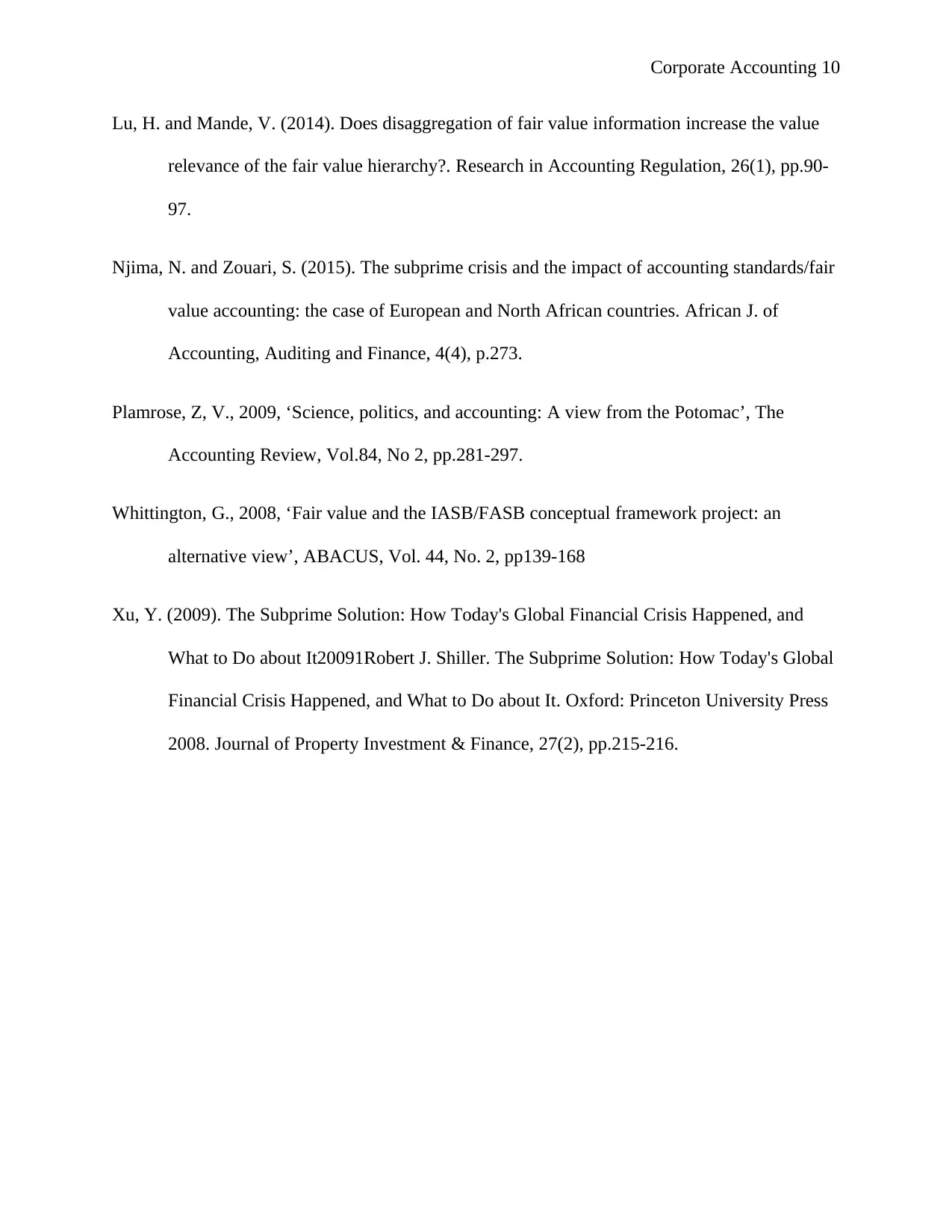
Corporate Accounting 10
Lu, H. and Mande, V. (2014). Does disaggregation of fair value information increase the value
relevance of the fair value hierarchy?. Research in Accounting Regulation, 26(1), pp.90-
97.
Njima, N. and Zouari, S. (2015). The subprime crisis and the impact of accounting standards/fair
value accounting: the case of European and North African countries. African J. of
Accounting, Auditing and Finance, 4(4), p.273.
Plamrose, Z, V., 2009, ‘Science, politics, and accounting: A view from the Potomac’, The
Accounting Review, Vol.84, No 2, pp.281-297.
Whittington, G., 2008, ‘Fair value and the IASB/FASB conceptual framework project: an
alternative view’, ABACUS, Vol. 44, No. 2, pp139-168
Xu, Y. (2009). The Subprime Solution: How Today's Global Financial Crisis Happened, and
What to Do about It20091Robert J. Shiller. The Subprime Solution: How Today's Global
Financial Crisis Happened, and What to Do about It. Oxford: Princeton University Press
2008. Journal of Property Investment & Finance, 27(2), pp.215-216.
Lu, H. and Mande, V. (2014). Does disaggregation of fair value information increase the value
relevance of the fair value hierarchy?. Research in Accounting Regulation, 26(1), pp.90-
97.
Njima, N. and Zouari, S. (2015). The subprime crisis and the impact of accounting standards/fair
value accounting: the case of European and North African countries. African J. of
Accounting, Auditing and Finance, 4(4), p.273.
Plamrose, Z, V., 2009, ‘Science, politics, and accounting: A view from the Potomac’, The
Accounting Review, Vol.84, No 2, pp.281-297.
Whittington, G., 2008, ‘Fair value and the IASB/FASB conceptual framework project: an
alternative view’, ABACUS, Vol. 44, No. 2, pp139-168
Xu, Y. (2009). The Subprime Solution: How Today's Global Financial Crisis Happened, and
What to Do about It20091Robert J. Shiller. The Subprime Solution: How Today's Global
Financial Crisis Happened, and What to Do about It. Oxford: Princeton University Press
2008. Journal of Property Investment & Finance, 27(2), pp.215-216.
1 out of 10
Related Documents
Your All-in-One AI-Powered Toolkit for Academic Success.
+13062052269
info@desklib.com
Available 24*7 on WhatsApp / Email
![[object Object]](/_next/static/media/star-bottom.7253800d.svg)
Unlock your academic potential
Copyright © 2020–2025 A2Z Services. All Rights Reserved. Developed and managed by ZUCOL.





